Russia's Revenge
Written by Rick Archer
July 2014
|
As we all
know today, the Alaska Purchase was without a question one of the
greatest real estate swindles in history. Shortly after the
conclusion of the Civil War in 1867, upon the advice of
William Seward, Secretary of State, the United States government
acquired this vast northern paradise for the princely sum of 2 cents
an acre.
Oddly
enough, at the time, most commentators assumed Russia got the better
end of the deal. For example,
The New York Tribune's Horace Greely
exclaimed:
"Alaska
contains
nothing of value but furbearing animals, and these
animals
have
been hunted until they are
nearly extinct. Except for the Aleutian Islands and a narrow
strip of land extending along the southern coast,
the
land
would not
even be
worth taking as a gift."
And then
one day they discovered yellow gold in Alaska. That changed
people's opinions in a hurry. Then they discovered oil - black
gold - in Alaska.
Now it was
obvious that Russia had made an enormous blunder.
However,
Russia got even in a manner of speaking. Here is a little
known story from World War II about Alaska where Russia actually got
some payback.
|
 |
|
Round One: Seward's
Folly
|
 |
Rick
Archer's Note: As we stare
at the map, just on size
alone, one would wonder why so many
people would object to the deal. In a
word, Alaska is gigantic.
After acquiring Alaska, the USA
immediately grew in size by 20%.
Alaska is
so big that is easily twice the size of Texas.
Alaska is so big that it is larger than
all but 18 sovereign countries in
the world. Alaska is bigger than France,
the second largest country in
Europe. And get this - Alaska
all by itself has more "coastline"
than all the other 49 states put
together.
And get this - even
though we robbed Russia blind, U.S.
Secretary of State William Seward was
severely criticized for his "colossal
mistake". Calling the deal "Seward's
Folly", the press practically labeled Seward
a complete idiot.
Seward was right all
along, but he had fits getting people to understand his vision.
The sad thing is that he died shortly before the Klondike Gold Rush
came along to vindicate his dream. If you haven't
read the story of
Seward's Folly, you would
find it very fascinating.
Yes, America
robbed Russia blind, but you know
what?
Russia got us back.
Let's find out how
Russia used "Alaska" to get even.
|
History is
Full of Gambles
|
One of
our favorite sayings is that "Hindsight is 20-20".
History is full of many gambles where things could
have easily
backfired. For example, the decision to fly
into Pakistani air space on the hunch that
Osama Bin Laden was hiding there carried huge
risks. That raid on Bin Laden could
have just as easily gone wrong in a
million horrible ways. Then what would have
happened?
There once was a very similar raid.
Operation Eagle Claw in 1980 was an
operation ordered by President Jimmy Carter
to attempt to end the Iran hostage crisis.
He was attempting to rescue 52 diplomats
held captive at the embassy of the United
States in Tehran.
The operation encountered many obstacles and
was eventually aborted. Eight helicopters
were sent to the first staging area, Desert
One, but only five arrived in operational
condition. One encountered hydraulic
problems, another got caught in a cloud of
very fine sand, and the last one showed
signs of a cracked rotor blade. During
planning it was decided that the mission
would be aborted if fewer than six
helicopters remained, despite only four
being absolutely necessary. In a move that
is still discussed in military circles, the
commanders asked President Carter for
permission to abort and Carter granted the
request.
As the U.S. force prepared to leave, one of
the helicopters crashed into a transport
aircraft which contained both servicemen and
jet fuel. The resulting fire destroyed both
aircraft and killed eight servicemen.
In other words, these gambles don't always
work out the way people expect them to.
Today thanks to Iranian belligerence, Iran's
nuclear program poses an existential threat
to the nearby state of Israel. The proposed attack on Iran's
nuclear program could easily backfire in a million
horrible ways.
Fortunately for you and I, American History is
mostly full
of gambles that worked out. Otherwise we
wouldn't be here today, now would we?
That said, sometimes
our gambles have succeeded by the skin of their
teeth. Of course the American Revolution is
the best example. Trying to break away from
England seemed like the right thing to do, but we succeeded by the
thinnest of margins.
We nearly lost that war.
In fact, we should have lost that war.
Another
famous gamble was our attempt to land troops on the
European continent on D-Day. One of
the favorite jokes about D-Day is that we would all
be speaking German today if we had failed in that
bold attempt to break through the Atlantic Wall.
We all
know how D-Day turned out, so we have no idea the
fear that gripped the Allied Command on that fateful
day. Eisenhower himself was so full of doubt
that he wrote a speech ahead of time taking
responsibility for the failure.
In my
research on D-Day, I was struck by the fact that
there was no guarantee of Allied success as those
boats crossed the English Channel. The
invasion was based on a risky strategy that somehow
the Germans could be fooled as to the time and
location of the attack. Any leak in security
could have easily doomed the entire mission.
Fortunately the Allies were able to fool the
Germans and surprise them with their choice of
landing point, but even then the fighting did not go well.
The Americans had it the worst. Indeed, with
all its men pinned down by machine gun fire at
Omaha Beach, throughout the morning it looked for certain that there was no
way the Americans would win that fight. In
fact, General Omar Bradley was so certain this
battle was lost he wanted to have the men "retreat".
Unfortunately,
with the men stuck on the beach, no recall was
possible and there was no way to rescue them.
For about two hours that morning, Bradley was beside
himself with misery. To him, it looked like
every man was a goner.
And
then suddenly the tide turned. Do you know how
the men turned an almost certain defeat into an
amazing come-from-behind victory?
Well,
read my story and find out:
D-Day and Omaha Beach After what you
read, you will be amazed that we ever won that
battle. It took some real ingenuity and
courage to turn the tide.
Not everybody in
American History was as smart as William
Seward or our leaders in World War II. For
every American Visionary like William Seward, over time we have
also
had men in our government and military who
didn't necessarily use a lot of common sense.
Let's
face it - American History has more stories
about the gambles that paid off than we do about the
gambles that failed. But we have had our
failures too. Think Korea. Think
Vietnam. More and more, Iraq seems like a
failure as well.
What we
don't read about very often in the annals of America
History are the stupid things we do. Before I
share the story of "Russia's Revenge", I would at least like to point out
that one of great things about America is that I
have the right to write about it. Other
countries aren't so fortunate.
Thanks
to our tradition, here in America we have the chance
to learn from our mistakes.
And now,
here is Russia's Revenge in Alaska,
a little known story of American ignorance.
|
Russia
On the Verge of Collapse
|
As was pointed out earlier, people
like to say that if D-Day had failed, we might just be
speaking "German" here in America today. Oddly
enough, thanks to an incident that took place during
World War II, today we could just as easily be
speaking Russian as well.
As background to this story,
let's talk about Russia's role in World War II.
In the days preceding World
War II, Great Britain's Winston Churchill and
American President Franklin Delano Roosevelt had
trouble deciding who was the bigger thug... Adolf
Hitler or Russia's Joseph Stalin. Both
men were monsters of the highest magnitude.
Churchill and FDR knew that
Stalin and Hitler were seriously paranoid about the
other. Both men were strongly suspicious of
the other's intentions. I often wonder
if Churchill and FDR ever wondered what would happen
if those two monsters teamed up?
At the outbreak of World War
II, Churchill and FDR were in for a nasty surprise.
They discovered the Soviet Union and Germany had
signed a non-aggression pact in August 1939.
This took place shortly
before the German invasion of Poland that triggered
World War II. Many people are unaware that
Germany's invasion of Poland was matched by a Soviet
invasion of Poland from the east.
A secret
protocol to the pact outlined an agreement between
the Third Reich and the Soviet Union on the division
of the border states between their respective
"spheres of influence". This
willingness to share Poland had to drive a huge
stake of fear into both the American and British
leaders.
The pact surprised the world
because of the parties' previous mutual hostility and their
conflicting ideologies. These two
countries were historic enemies, but suddenly they
appeared to be cooperating. This was very bad
news.
Unfortunately for Churchill
and FDR, the secret pact seemed to be working quite
well to the benefit of both countries. The
willingness of Hitler to share a bone with Stalin
had to be a chilling thought indeed. Not only
had the Soviet
Union and Germany split Poland, Germany said it had
no objection to further Soviet aggression.
Latvia, Estonia and Finland were defined as falling
within the Soviet sphere of influence and Stalin
wasted no time exercising his option.
As a result of the pact,
Germany and the Soviet Union had reasonably strong
diplomatic relations and an important economic
relationship. It is difficult not to speculate
how things would have turned out if the two
countries had continued to maintain the truce.
Fortunately for the entire
world, Hitler just couldn't resist the temptation to
make a move on Russia.
We all know D-Day was a major
turning point in World War II, but more likely the greatest
turning point of
World War II involved Hitler's decision to betray Russia
and attack the sleeping giant. This was
probably the greatest mistake Hitler ever made.
Russia seemed weak.
Their army was poorly organized and lacked weapons.
Joseph Stalin's reputation as a brutal dictator
contributed to the Nazis' faith in their likely
success.
Stalin was a madman.
Deeply paranoid, he was constantly worried about an
overthrow by the military. He didn't trust
anyone. In the late 1930s, Stalin had ordered
many competent and experienced military officers
killed in the Great Purge. In total, some
30,000 Red Army personnel were executed, while more
were deported to Siberia and replaced with officers
deemed more "politically reliable". This had
left the Red Army with a relatively inexperienced
leadership compared to that of their German
counterparts. This military weakness plus
Hitler's belief in the inferiority of the Russian
people led him to assume it was an easy victory.
If so, why bother honoring the Russia-Germany
non-aggression pact?
In a nutshell, Hitler got
greedy. He decided Germany needed "Lebensraum"
- room to live. Hitler dreamed of the vast
Russian territory in which the German people could
expand into and spread their Aryan bloodlines far
and wide. Besides the huge frontier, the
breadbasket of the Ukraine and the mineral wealth of
the Soviet Union proved far too inviting to resist.
Hitler's military experts
begged him to reconsider. Germany was winning
the war. Why take such a dangerous gamble?
No such luck. Hitler
refused to back off.
Hitler disagreed with the
strategists and economists about the risks. He
told Hermann Göring, the chief of the Luftwaffe,
that "everyone on all sides was always raising
economic misgivings against a threatening war with
Russia. From now on he was not going to listen
to any more of that kind of talk or he was going to
stop up his ears with wax in order to get his peace of mind."
Like Stalin, Hitler was full
of madness as well. Hell or high water. he was determined to
attack Russia.
It was a colossal mistake, but
no one would have guessed this at the start of
conflict.
Germany severely punished Russia with its far
superior war machine. With tanks rolling
across the Russian plains against virtually no
opposition, Germany actually made it
to the outskirts of Moscow. Now it seemed like
victory was almost certain.
And then it all came to a
stop. Can you guess what happened?
The Russian winter kicked in.
Ironically, Germany had started its campaign one
month later than the military experts had suggested.
Now as the snows fell, it turned out the military
prediction was totally accurate. Too late now.
Many of the German soldiers didn't even have winter
coats and the equipment was breaking down right and
left.
Like Napoleon two hundred
years earlier, Hitler had come very close to
conquering Russia. Like Napoleon, Hitler was
handed a brutal defeat that came as a total shock.
Surely the frozen ghosts of Napoleon's army, victims
of the same cruel Russian winter two centuries
earlier, had grim faces lined with ironic smiles.
Doesn't anyone learn anything from history??
Meanwhile Churchill and
Roosevelt watched the battle on the Eastern Front
with morbid fascination. Not only were they
unsure who would win, they weren't even sure who
they wanted to win.
Churchill and Roosevelt didn't
mind one bit seeing the Russian Army and the German
Army murder each other. From their vantage
point, Stalin looked every bit as dangerous as
Hitler.
One thing Churchill and
Roosevelt completely agreed on was the need to get a
foothold in France. If Germany collapsed, the
Red Army would annex as much of the German empire as
it possibly could. Both men knew that Stalin's
end game was to create a Russian Empire on the
graves of the fallen Third Reich.
Given what we now know about the ensuing Cold War,
Churchill and Roosevelt were completely correct in
their predictions. This explains why Stalin
was treated as both an ally and an enemy by the
Allies throughout World War II.
|
|
|
|
Alaska in
World War II:
The Battle of Attu,
Lend Lease, and
the Alaska Highway
|
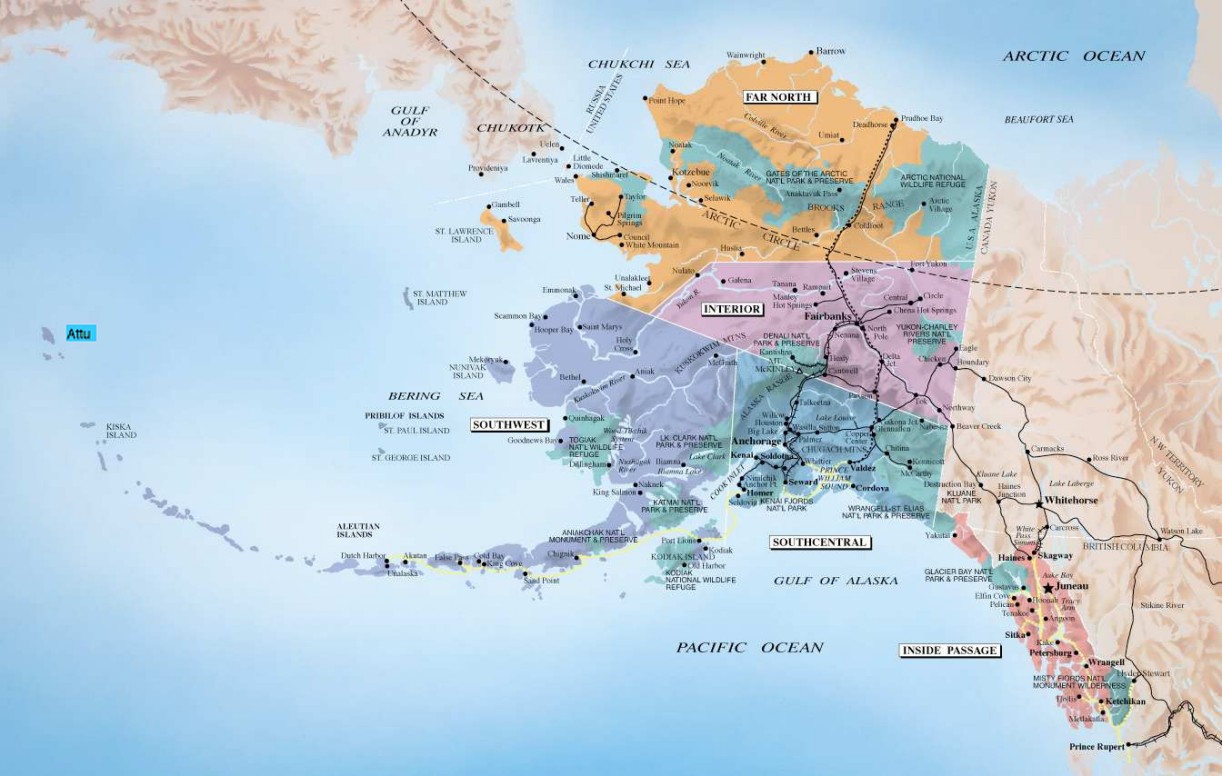
The Battle of Attu
When I visited
Alaska in June 2014, I was surprised to learn a
major conflict between the U.S. and Japan took place on a
remote Alaskan
island during World War II. The Battle of Attu
was waged over a two week period, May
11–30, 1943.
Attu Island is
located roughly halfway between Alaska and Japan. It
is 1,400 miles northeast of Japan and 1,000 miles southwest
of Alaska's coast.
The strategic position of the
Aleutian island of Attu
meant this location could control the sea lanes across the
Northern Pacific Ocean.
Japanese
planners believed control of the Aleutians would therefore
prevent any possible U.S. attacks from Alaska.
|
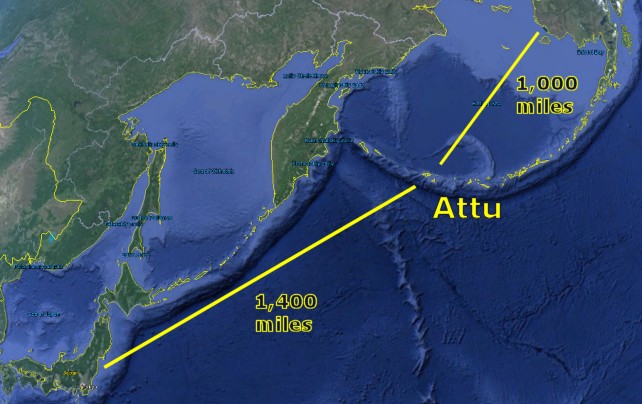 |
The Americans
agreed.
U.S. General Billy
Mitchell told the U.S. Congress in 1935, "I believe that
in the future, whoever holds Alaska will hold the world.
I
think it is the most important strategic place in the
world."
On 7 June 1942,
six months after the United States entered World War II
thanks to Pearl Harbor, the
Japanese Northern Army landed unopposed on Attu.
The U.S. military
was keenly aware of their presence. They now feared
the island could be turned into strategic Japanese airbases
from which aerial attacks could be launched against the West
Coast of North America.
Unfortunately,
Pearl Harbor had left the military too disorganized to mount
an immediate counter-attack. Attu would have to wait.
One year passed.
In May 1943, units of the U.S. 7th Infantry Division made
amphibious landings on Attu to retake the island from
Japanese Imperial Army forces led by Colonel Yasuyo
Yamasaki.
Despite heavy
naval bombardments of Japanese positions, the American
troops encountered strong entrenched defenses that made
combat conditions tough. Arctic weather conditions and
exposure-related injuries also caused numerous casualties
among U.S. forces. But the Americans refused to quit.
After two weeks of relentless
fighting, American units managed to push the Japanese
defenders back to a pocket around Chichagof Harbor.
Encircled and cut off from any hope of rescue, on May 29th Yamasaki led his
remaining troops in a banzai charge. The momentum of the
surprise attack broke through the American front line
positions. Shocked American rear-echelon troops now found
themselves
fighting hand-to-hand combat with fanatic Japanese soldiers. The
battle continued until almost all of the Japanese were
killed.
With the
desperate last-ditch charge repulsed, this conflict effectively ended the battle for the
island.
In 19 days of battle, 549 soldiers of the 7th Division were
killed and more than 1,000 injured. The Japanese lost over
2,850 men. The Japanese had been determined to fight to the
last man and they nearly succeeded. Only 29 prisoners were taken alive.
|
|
|
|
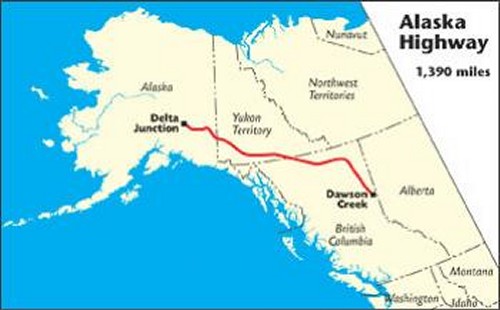 |
Alaska Highway
Prior to World
War II, the only way to get to Alaska was by plane
or boat. That situation quickly changed when
we went to war with Japan.
We all
know that Hawaii maintains an important military
presence in the Pacific. Any visit to Pearl
Harbor will strongly reinforce that notion.
It turns
out that Alaska has a powerful military presence as
well. Alaska serves as an important outpost
against any aggression coming from an Asian nation.
|
|
In many ways, it
was World War II that served to underscore Alaska's
importance to our nation. For example, the intolerable
situation on Attu Island reinforced the military's
conclusion that Alaska needed to play a major role in
America's defense.
To protect all
of
North America, Canada and the United States worked as one
nation during the war. The two countries agreed Alaska
was a key point in mutual defense. So construction on
the new Alaska Highway was
begun for the purpose of
connecting the contiguous United States to Alaska by way of
Canada.
Originally named the
ALCAN
Highway (short for Alaska-Canada), this
route was built to help protect both Alaska, America
and Canada in case of
Japanese attack.
Even before the
problems on Attu Island, the military assumed that Alaska
would
play a major role in the war due to its proximity with Japan
as well as Russia.
Since shipping by water was far more risky than shipping by
land, the decision to build the highway was very practical.
With this road, they could rush
men, tanks and supplies to the north no
matter what the weather conditions were. Equally
important, the new highway would link together a series of
vital airbases being built in Alaska and Canada.
Many people are surprised to learn that the majority of the
Alaska Highway is actually located in Canada. This is
due to the fact that Alaska has no land link to the Lower
48.
Alaska is what
is known as an "exclave", i.e. a territory that is not
directly connected to the Lower 48 States (Hawaii and Puerto
Rico are also "exclaves").
|
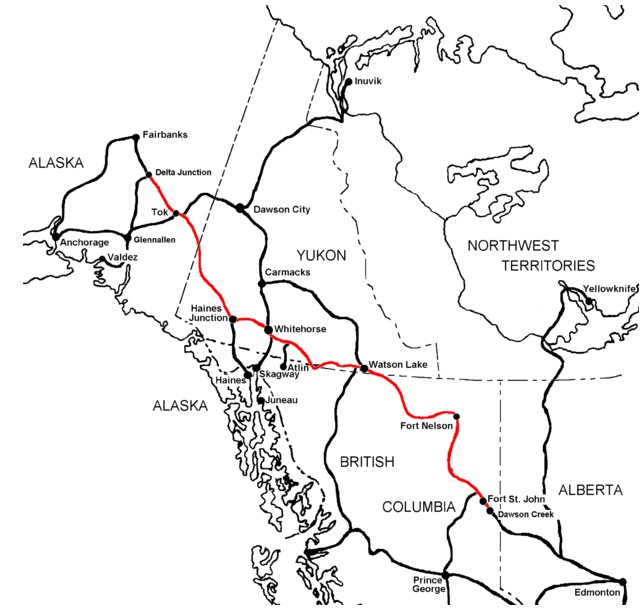
The Alaska Highway is drawn in red
|
It is over 500
miles from Seattle, Washington, to Ketchikan, the
southernmost point of Alaska. That's a long way to
build a bridge... so they used Canada instead.
Since there
was no
convenient strip of USA soil to connect
Alaska to the rest of the USA, the only
way America was able to build this highway was to enlist the
cooperation of our Canadian friends to the north.
The Alaska
Highway begins in Dawson Creek, British Columbia. Dawson Creek was
chosen because it is a junction point for several Canadian
highways. From Dawson
Creek, the highway runs to
Whitehorse in Canada's Yukon province and
then on to Delta Junction in Alaska.
Completed in 1942, the
final distance was 1,390 miles long.
After the war,
the Alaska Highway was opened to the public in 1948.
Unfortunately, at the time the road was more fit for an army
jeep than a family car.
Legendary for many decades as being a rough, challenging
drive, today's modern highway is nicely paved over its entire length.
|

Today's Alaska Highway is a valuable
link to this great state.
|
The USA-Russia Lend Lease
Program
|
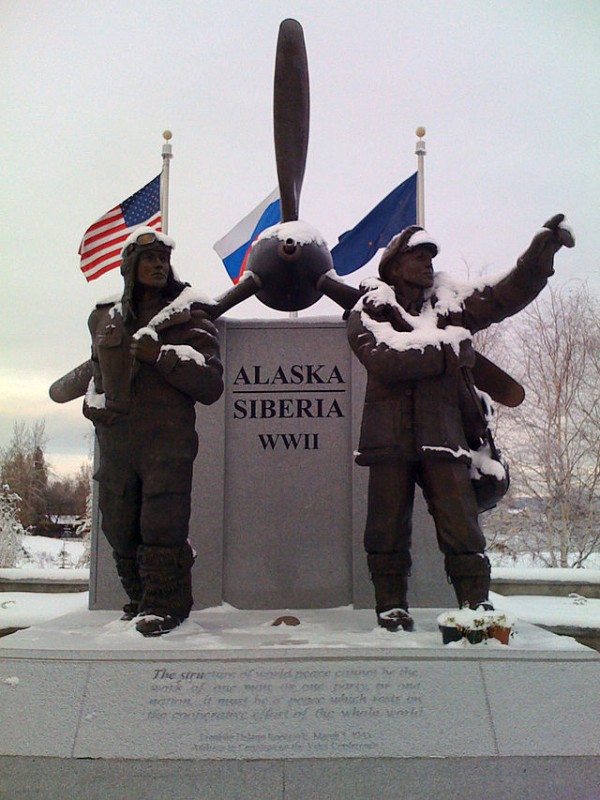
The
Lend-Lease Memorial in Fairbanks, Alaska, commemorates the
shipment of U.S. aircraft to the Soviet Union along the
Northwest Staging Route. I saw this monument during my
June 2014 visit to Fairbanks, but was unaware of its
significance at the time.
|
The fact of the matter is that the Cold War was
Russia's doing.
America did everything
possible to help Russia overcome the dangerous
German invasion. America showed friendship and
was rewarded with betrayal and constant threats of
war.
During
World War II, the United States used the proximity
of Alaska
to aid the Soviet Union against Germany. America
had a "Lend-Lease" pact with the USSR.
Great
Britain was on its heels under constant attack by
the German Luftwaffe.
America basically kept Great
Britain alive thanks to Roosevelt's "lend lease"
program. Tons of food and military supplies
were shipped to Great Britain during those terrible
months when German bombers raked the countryside.
Without America's help, Great Britain probably could
never have withstood Hitler's assault.
Once
Germany attacked Russia, America commenced a similar
program. Russia's military lacked arms and its
people were starving. Sensing imminent collapse,
Roosevelt authorized a similar Lend-Lease
policy for the USSR.
Lend-Lease provided vital help for the Soviet Union
when the country was in desperate straits.
America made a
significant contribution to the final victory. It
also strengthened Josef Stalin. This fact did not
escape Roosevelt, who saw beyond the Allied victory
and looked at Stalin with increasing dread.
Some of
the supplies were sent to Murmansk, a Russian port
near the northernmost part of Norway. Other
supplies were shipped north from Iran.
However, the most valuable (and safest) route of all
proved to be Alaska.
With the
outbreak of war, American lines of communication
with Alaska by sea were seriously threatened by
Japan. Alternative routes had to be opened.
Consequently a string of hastily built airports
through the lonely tundra and forests of northwest
Canada provided an air route to Alaska which was
practically invulnerable to attack.
When the
Russian Lend-Lease campaign began, the Alaska
Highway had just been started. It seemed to be in
the best interests of international defense to open
a highway which would at once be a service road for
the airports and a means for transporting essential
supplies to the Alaskan outposts.
In response to
this need, United States Army engaged in the Alaskan
Highway project.
|
American
aircraft were a major part of the Lend-Lease
program. That's right, the USA gave Russia
airplanes as well.
Due to the close proximity of Siberia
to Alaska, American pilots flew massive transport planes over to Russia.
After the planes landed in Siberia, the frozen
eastern part of Russia, the planes were then flown by Russian
pilots across the vast expanse of Siberia to
distribute food and supplies to Russia's Eastern
front. This is how American supplies were
shuttled all the way across the USSR.
Of
course the Russians appreciated the lifeline.
But they wanted something else... Stalin coveted
America's new line of long range bombers... the
B-29, the Flying Fortress.
|
|
|
|
The B-29 Flying
Fortress
|
After the Japanese bombing of Pearl Harbor,
President Roosevelt had a burning desire to
retaliate by bombing Japan.
This became an obsession with him, but Japan was out
of range. The only long range bomber in our
arsenal was the B-17, but it maxed out at 1,000
miles. So the idea of reaching
Japan became increasingly remote. How were we going
to accomplish this seemingly impossible feat? We
needed a Super Bomber, but did not even have one on
the drawing board.
Roosevelt turned to General H.H. "Hap" Arnold.
General Arnold was already pushing for a more
sophisticated Air Force with long range capability.
Arnold sent a request to all the aircraft companies
seeking designs for a Super Bomber. Boeing had been
working on such a design and won the contract.
They
were to deliver two flying prototypes by 1942. It
was to be the fastest, largest, heaviest plane ever
mass produced. The U.S. ordered 250 sight unseen.
Then Germany attacked Russia. The number was quickly
increased to 500 planes.
On September 21, 1942, the
Boeing XB flew out of the Seattle plant. This
$3 billion dollar gamble was the largest government
commitment ever to a single project, including the
Atomic Bomb. The advances were startling.
Never before had so many new ideas been put together
so rapidly in a single aircraft.
The
first bombers were sent to the CBI area (China,
Burma, India). With a range of 5,000 miles, these lethal aircraft
began to bomb Japan into submission.
Noting
the power and effectiveness of these long-range
bombers, the USSR repeatedly asked to be given
lend-lease American B-29s. They were always
turned down. No sane person would dream of
allowing the Soviets to get their hands on these
bombers.
The
American pilots were supposed to return to China
after bombing Japan. However,
America needed a place for planes to land
after bombing Japan if they were badly damaged. So Roosevelt asked Stalin
for permission to land in Siberia.
Stalin
evaded answering the request. Russia had their
hands full fighting the Germans. However,
since Russia was not at war with Japan, Stalin did not
want to open up another front by aiding the U.S. air
force and taking on Japan.
By giving no answer, Stalin stayed neutral.
Roosevelt understood why permission wasn't being
granted. However, Russia was an American ally,
yes? Roosevelt assumed they could not refuse
an emergency landing.
The word
was passed down. In an extreme emergency, the crews were given
permission to land in Vladivostok, Russia.
On the
morning of July 31, 1944, Capt. Howard Jarrell and
his 10-man crew took off from Chengtu, China, on a
mission against a Japanese steel mill in Anshan,
Manchuria.
Capt.
Jarrell's plane made a normal bomb run and may have
been hit by a flak burst, but any damage was at most
minor. When the pilot started his descent to
cruising attitude for the trip back to Chengtu, the
inboard right engine "ran away" and could not be
feathered (turning the propeller blades parallel to
the airflow to minimize aerodynamic drag).
The
engine had to be shut down and the increased drag of
the unfeathered propeller made it obvious that the
plane would not be able to safely get back to Chengtu due
to insufficient fuel.
The plane was still over Japanese territory so the
crew began destroying all classified material on
board including operating manuals, orders and
instructions in case they were forced down in enemy
territory.
|
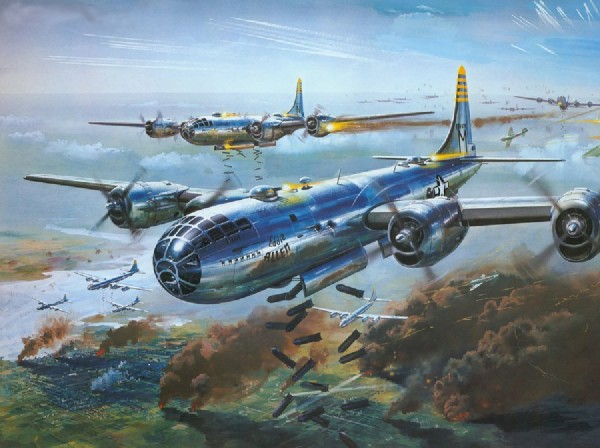
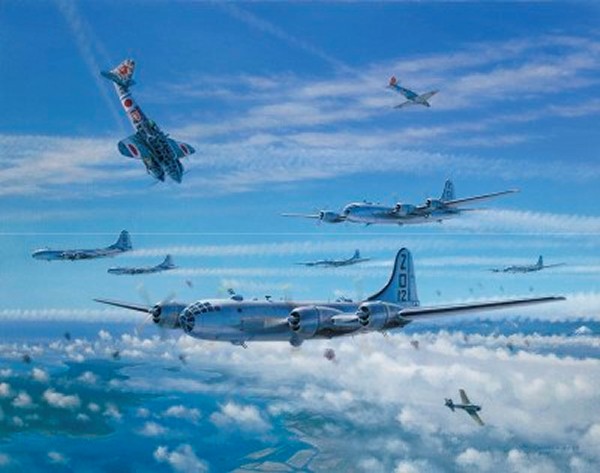
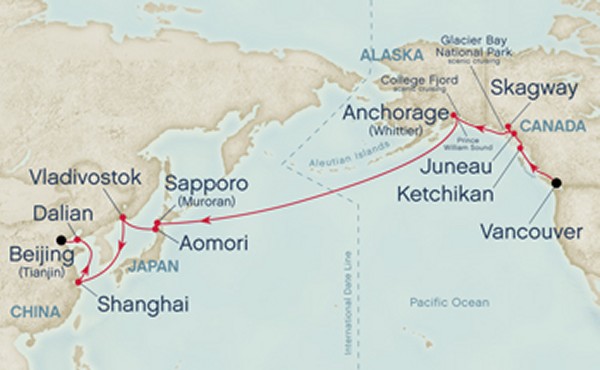
Vladivostok is approximately 500-600 miles northwest
of Japan
|
Now what
to do??
Captain
Jarrell decided to follow the emergency orders.
The pilot headed toward the Russian base
at Vladivostok to land the damaged plane in what he
assumed was Allied
territory.
As the
bomber approached a Russian airfield, a squadron of
Russian fighters was scrambled to "escort" the
plane.
The
Russian planes fired near the B-29, but it was
unclear whether they were trying to hit the plane or
force it down. Capt. Jarrell was confused.
Was this threatening gunfire necessary? Weren't the Americans and the Russians supposed to
be allies?
However, it was too late now
to turn around, especially with the hostile Russia
escort on either side of his crippled ship.
Jarrell had no choice but to land here. After a few
more minutes of this firing nonsense, a
Russian fighter pilot motioned for the plane to
land. The B-29 began to head toward a field with a
concrete runway, but the fighters started shooting
again and indicated the plane should land at the
grass fighter strip.
This was
a dangerous move that put the plane and its crew at
risk. Although
the grass field was too small for a giant B-29, Capt.
Jarrell lined up to land since he had no choice. As
he lowered the landing gear, all the shredded
classified material stored in the nose wheel well streamed out and
fluttered down into the waters of Vladivostok Bay. The plane
touched down at just above stalling speed and
stopped just before running off the end of the
runway. It had been tight, but everyone was
safe.
After
landing, Capt. Jarrell ordered the crew to stay
aboard the B-29 while he left and tried to
communicate with the Russian pilots.
Unfortunately, none spoke
English. A few hours later, the crew left the plane
and joined Capt. Jarrell on the tarmac.
Eventually the Russians located an interpreter. Capt.
Jarrell asked to be allowed to contact the American
Consul in the city, but permission was denied. The
Russian "Allies" interrogated the American crew for
three days trying to obtain operational details
about the plane and its capabilities. The crew
refused to divulge secret information, but the
Russians were relentless. Finally, after
three days of endless questioning without contact from the
American Consul, the crew took a vow of silence.
If they were going to be treated as enemies, they
would refuse to speak. This went on for
an entire week.
On the
11th day after landing, the crew was finally allowed to
speak with the Consulate located in Vladivostok. Unfortunately, the crew
was not released to the consulate. They were
forced to remain
prisoners of the Russians for seven months before
being released along with about 100 other U.S. Army
and Navy fliers who had also been forced to land in Russian territory
during WWII.
Jarrell
later said with bitterness that the Soviets had not
been even remotely
friendly to him or his men. But he could never forget how overjoyed
they were to see the B-29 on their runway. He
spoke enough Russian to understand they referred to
the plane as a 'gift'.
As he
watched the Soviets feast their eyes on the majestic Superfortress, Jarrell overheard one Russian general
call the plane 'dar Bozhii'... a gift from God.
Jarrell
shook his head in frustration. Jarrell wished
he had landed the aircraft in the sea nearby and taken his
chances.
|
|
|
|
Andrei Tupolev
|
Andrei Tupolev (1888-1972) was a Russian aviation engineer
who was nothing short of a genius. Tupolev had been
designing aircraft practically his entire life. During his
career, he designed and oversaw the design of more than 100
types of aircraft, some of which set 78 world records.
In 1925, he designed a twin-engine bomber, the TB-1, which
was considered one of the most advanced designs of the time.
1937 was the
year when the TB-3, an improved version of the TB-1, made a
successful landing in extreme weather conditions at the
North Pole. Flown by the celebrated Russian aircraft
test pilot Valery Chkalov, not only did the plane make a perfect landing,
the plane was later able to take off without a problem as
well.
One would assume
such a triumph would be rewarded, but instead Tupolev met
with a bizarre fate. Scarcely four months after
pilot Chkalov’s flight to the Arctic, Tupolev was caught in the madness of
Josef Stalin’s party purges.
On October 21,
1937, Tupolev and several fellow engineers were
arrested on trumped up charges of sabotage and espionage.
Records released
in 1997 from the KGB archives show that the charges against
Tupolev were very serious.
The documents indicate that Tupolev was found guilty by the
Military Collegium of the Soviet Supreme Court. Not
only was Tupolev accused of
aiding the Russian Fascist Party, Tupolev
was accused of selling Soviet aircraft designs to Germany.
|
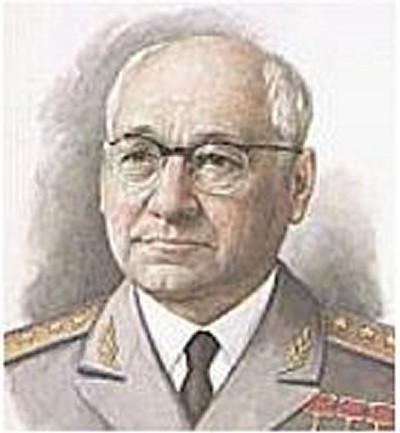 |
The charges:
“Comrade Tupolev
was guilty of having
led a harmful anti-Soviet organization within the Soviet
aviation industry and, personally and through his agents,
conducted harmful sabotage with the aim of weakening the
Soviet Union’s defense capabilities. Additionally, Tupolev
was said to have been an agent of French intelligence since
1924 and . . . has turned over Soviet secrets to French
intelligence.”
It is unlikely
that Tupolev was guilty of any such thing, but that didn't
matter to the authorities. Under
torture, Tupolev had confessed to a wide range of “crimes”
against the Soviet people.
Tupolev expected
to die like many of his colleagues who had already been
executed, but to his surprise, he was spared. Instead
Tupolev was sent
to prison.
Two years
passed. Then in 1939, without
any warning, Tupolev
was taken from his jail cell and shoved into a car.
The secret police moved him from prison to a sharashka for aircraft
designers in Bolshevo near Moscow.
A "sharashka"
was the name given to the secret research and development
laboratories in the Soviet Gulag labor camp system.
The scientists and engineers at a sharashka were prisoners
picked from various camps and prisons and assigned to work
on scientific and technological problems for the state.
Living conditions were usually much better than in an
average taiga camp, especially bearing in mind the absence
of hard labor.
What Tupolev did
not know was that Stalin and his
secret police chief, Lavrenti Beria, had realized they had
made a mistake. War was threatening Europe. Now
without its guiding spirit, Soviet aviation was in chaos.
Tupolev was rescued from Moscow’s Butyrskaya prison and transferred to Bolshevo prison to head a new
design bureau controlled by Beria’s secret police, the NKVD.
Tupolev
discovered several other aeronautic engineers had
already been sent to work there, but the men he really
needed were missing. Now Tupolev created a Stalinist
version of Schindler’s list. He handed his
captors the names of some 150 imprisoned engineers and
scientists whom he declared essential to his patriotic work.
Beria dutifully
retrieved this elite cadre from throughout the Gulag
archipelago, undoubtedly saving the lives of most of them.
The men were grateful to their saving angel. It didn't take long for the sharashka to be given a new
name. It was dubbed Tupolevka in honor of its
most eminent inmate.
Ironically
Russia just couldn't leave the man in peace to do his work. Tupolev was
soon given another trial. He was tried and
convicted again in 1940, this time being handed a ten-year sentence.
No matter.
Russia was at war and in spite of the bizarre leadership, at
heart Tupolev was a patriot. Tupolev got to work.
While still prisoners, Tupolev and his fellow designers
created the Tu-2 bomber, a huge improvement over what the
Soviets had been using to date.
The Soviet
supreme court granted Tupolev clemency as the Nazis overran
western Russia in July 1941, just in time for him to
evacuate his workshop to Omsk, a far superior laboratory
safely located in a remote corner of
Siberia. Strangely enough, despite his accomplishments, Tupolev was still
constantly treated with suspicion. Tupolev
would not be fully rehabilitated until two years after
Joseph Stalin's death in 1953.
It has to be one
of the greatest ironies of history that the man who did as
much as any single Russian to save his country from the
German invasion did so as a prisoner of the state for
sixteen years.
Tupolev
Makes History
In 1944, Russia
got its big break when Captain Jarrell was forced to land
his bomber on Russian soil. Stalin could not believe
his good fortune. The USSR had repeatedly asked
unsuccessfully for lend-lease B-29s. Now the prized
American bomber was in his possession. Stalin rubbed
his hands with glee. He quickly ordered his men to
confiscate the plane. Then he contacted Andrei
Tupolev.
Tupolev was assigned to head the major project of reverse
engineering the American Boeing B-29 strategic bomber.
Tupolev began to copy the American plane bolt for bolt, wire
for wire.
It took him only
one year. In 1945, Tupolev
succeeded in creating an exact replica of the original down to the most
trivial detail. To his delight, the "Russian clone"
flew perfectly on its first trial. Ironically, just
about the time Tupolev made his breakthrough, the Enola
Gay, another B-29, became the world's first nuclear
delivery platform when it dropped the atom bomb on
Hiroshima.
Now Tupolev got
the plane into volume production. Over the next two
years, he made sure that crews were fully trained in time
for the 1947 May Day parade.
Western observers watched in
shock as a brand new Tupolev TU-4 proudly flew overhead. At
first, they thought the giant plane was the same B-29 that Stalin had stolen
from them, but cold
chills ran down the spine of these observers once they
realized this was not the same plane at all, but something
the Soviets had created. At the time, the Western
experts did not know the story behind this plane, but they understood
immediately the implications. For the first time, the Tupolev TU-4 gave the
Russians the capability to reach any industrial centers of
North America they wished to attack.
This had been a remarkable engineering
accomplishment. Its success spoke volumes about the genius of Tupolev.
Thanks to him, the
Russians were able to successfully copy America's top secret bomber. This act of Cold War piracy
landed quite a blow to America's sense of security.
One of our most closely guarded technologies was now in
Russian hands.
At
the time, these bombers were the world's first and only
nuclear delivery platform. Thanks in large part
to American negligence, the USSR now had a way to bomb the
United States using its own weapons against them.
Slowly but
surely the details behind this technological breakthrough
leaked out. American engineers were aghast. How
on earth did the Russians do this? The U.S. had
previously not believed the Russians had the capability to
clone the B-29; it seemed totally inconceivable. However, the public
debut in the Russian Aviation Day parade in 1947 changed
their minds.
The U.S. found itself in a panic situation when
they learned the TU-4 was indeed a reality, capable of
hitting any target in the U.S. Now there were
reports of missions taken by hundreds of TU-4s
practicing for a potential attack on
U.S. soil. The planes would fly to the edge of North
America and turn around. This intolerable
situation forced an enormous new
round in arms buildup. The Americans had no choice but
to beef up their Radar systems, surface to air missiles, and
interceptor jet fighters.
Thanks to
America's "trust" in the Russians, the Russians had been
given a huge head start into the Cold War.
Interestingly,
the experience of reverse engineering the B-29 would pay
even more dividends for Russia. The MiG-15 (known as
"the Mig") was a superior Russian
fighter plane of the early 1950's. This plane was so
dangerous that it shot down several American B-29s during
the Korean War and forced the entire fleet of planes to be
grounded.
And where did
this new plane come from? The lessons learned from
"reverse engineering" the B-29 were transferred to a plane
design confiscated from the Germans. The precision in
manufacturing required by the Tupolev project was
transferred directly into
the MiG program.
There was only
one problem... the German plane lacked a superior engine.
No problem. Someone suggested buying a prototype Rolls
Royce engine from Great Britain.
Everyone
laughed. No one was that stupid. But the
Russians decided to ask anyway.
Keen to thaw
Anglo-Soviet relations, British Prime Minister Clement
Attlee invited Soviet scientists and engineers to come visit the
Rolls-Royce jet facility. He wanted to show them how the superior British
engines were made. In a show of further good will, Attlee further offered to license
production to the USSR. However, Attlee was no fool.
He cleverly extracted a solemn promise that
the engines would be utilized only for non-military
purposes. The Russians promised they wouldn't
dream of weaponizing the engine.
The offer
stunned the Americans, who protested loudly. Had the
British lost their minds? Had they forgotten the
lessons of the confiscated B-29?
And the
Soviets?
Russian aviation
historian and Ukrainian native Ilya Grinberg says, “At the
time, Stalin
couldn’t believe it. Stalin said, ‘Who in their right
mind would sell anything like this to us?’ ”
Grinberg added,
“In fact, the
project to duplicate the B-29 dragged not only the aviation
industry but all of the Soviet industries up to a higher level.
Once Tupolev showed what could be done, a sense of pride
infused the entire scientific community at what could be
accomplished. It also helped that Stalin stopped
killing off his top scientists.”
Those Rolls
Royce engines did the trick. The new MiG
first flew on the last day of 1947. Though the MiG
remained inexpensively built and very much spartan, the
finished product was rugged and reliable. And it was
fast.
The
Atom Bomb
Nor did it stop
there. The Soviet project to develop an atomic bomb
had actually begun shortly after the start of World War II thanks
to a clever deduction by one of its scientists.
Soviet physicist
Georgy Flyorov had been following the progress made by German,
British and American physicists into
uranium fission research. Now at the start of the war, Flyorov
noticed scientific journals had mysteriously ceased publishing papers on
the topic.
Flyorov
correctly deduced that this meant such research had
now been classified. He had a hunch what this
meant. So in April 1942, Flyorov wrote to Stalin.
In his letter, Flyorov pointed
out what he suspected was going on. He went on to cite the lack
of response he had himself had encountered while trying to generate
Soviet
interest in similar research. Flyorov warned Stalin of
the consequences of atomic weapons:
"...the results will be so overriding that it won't be
necessary to determine who is to blame for the fact that
this work has been neglected in our country."
In other words,
there would be no one to blame because there would be no one
to blame.
Stalin got the
message. He turned to
his
talented spymaster Lavrenti Beria and told him to
investigate. Beria began to recruit scientists abroad.
By
September 1942, Beria presented evidence of the
Western nuclear programs to Stalin. Stalin was
appalled. He asked Beria for advice.
Beria suggested Stalin launch a Soviet program to
develop an atomic bomb headed by Igor Kurchatov.
Beria added he had ways to "speed up" the research.
What
that meant was Beria had been successful in
penetrating the security cloak around America's
top-secret Manhattan Project. Thanks to its
supposed "ally" status, security was somewhat lax in
America where the USSR was concerned.
Beria
now made concerted efforts
to recruit even more scientists to keep tabs. Beria
knew full well that thanks to his "Atomic Spy Ring", Russia
would be able to liberally
borrow ideas from the West.
Indeed, the USSR would benefit enormously
from highly successful espionage efforts on the part of the
Soviet military intelligence. Well after the fact it
was discovered that several Manhattan Project scientists such
as Klaus Fuchs had consistently leaked valuable information of the American nuclear
project.
Furthermore
Germany was the gift that just kept giving. The Soviet
atomic project was charged with gathering intelligence on
the German nuclear energy project as well as the American
nuclear efforts; spymaster Beria was able to infiltrate the
German program as well as the American program. Consequently, after the war, the
Soviet Union knew right where to look. At their first
chance, Soviet secret police sent by Beria confiscated all German research facilities and
military reactors. In addition, Russia forcibly
removed the German scientists from Germany and put them to
work on the Russian project.
Now
Russia began to make up the lost ground in a hurry.
On 29
August 1949, in the deserts of Kazakhstan, then a
Soviet territory, Russia became the second nation after the United States to
detonate a nuclear device.
|
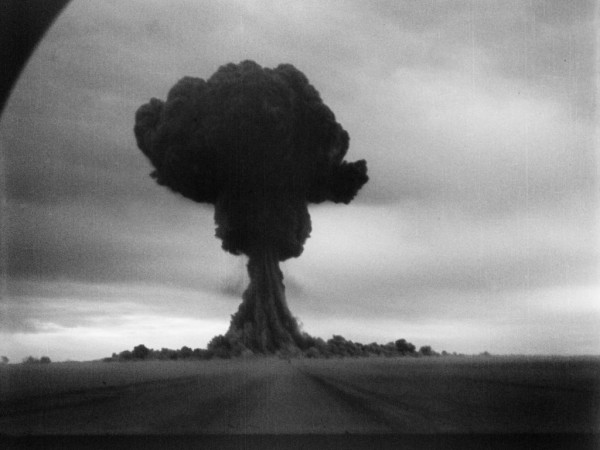
The RDS-1 was a top-secret Russian R&D project.
While not quite as impressive as America's bomb, it
was devastating nonetheless.
It was supposed to be a "secret", but apparently the
United States was well aware of what was going on.
The U.S. assigned it the code-name 'Joe-1' in
sarcastic reference to Joseph Stalin. The bomb
was exploded on 29 August 1949 at 7 am at
Semipalatinsk, Kazakh SSR.
|
Cold War
Surely anyone over 50
will recall the classic 1956 Khrushchev taunt... "We
will bury you."
Once
they discovered Russian missiles on Cuban soil,
suddenly Khruschev's threat didn't seem quite so
idle anymore.
I for one
remember our weekly atom bomb drills at school during
that period... as if that would have done any good.
"I remember President
Kennedy once stated... that the United States had the
nuclear missile capacity to wipe out the Soviet Union
two times over, while the Soviet Union had enough atomic
weapons to wipe out the Unites States only once... When
journalists asked me to comment... I said jokingly,
"Yes, I know what Kennedy claims, and he's quite right.
But I'm not complaining... We're satisfied to be able to
finish off the United States first time round. Once is
quite enough.
What good does it do to annihilate a
country twice? We're not a bloodthirsty people."
- Nikita Khrushchev, former Premier of Russia
 |
And there you
have it.
Thanks to
American and British generosity and naïveté, the Russians
came very close to winning the Cold War using weaponry
developed in America and Britain... and Germany as well.
Ah,
Germany. Russia
would have likely succumbed to the German onslaught were it
not for American aid.
And how did the
angry
Russian bear show its
gratitude?
They repaid us with treachery and
betrayal.
So much for
America's
Lend-Lease program. No good deed goes unpunished.
The story of the Soviet confiscation of the B-29 bomber
foreshadowed the deterioration of relations with the Soviet
Union, our supposed ally during World War II.
Sometimes we
have to wonder about just how smart our leaders really are.
Of course, to be fair, we have the benefit of hindsight.
In
retrospect maybe we should have let Germany win and
moved in right behind via Italy and Normandy while Germany
was preoccupied with Russian occupation.
It would be
interesting to know if that possibility was ever considered.
|
|
|
|
In this world,
there are fools everywhere. To begin with, what Russian fool would
dream of selling
Alaska to America? And what American fool said that
buying Alaska was "Seward's Folly", a complete waste of
money?
And what
American fool
thought that landing America's most valuable plane in Russia
was a good idea? Get out the parachutes, radio for
help, and put the damn plane in the water near the shore.
Then swim. Or better yet, toss out a life raft too.
And what British fool
decided that selling the world's most advanced airplane
engine to Russia was a good idea?
Stalin's master
plan worked to perfection. By conveniently filling the
vacuum created by the German collapse, he had untold
territory and knowledge fall right into his lap.
Using
technology gained from the Germans, Russia was able to close
the nuclear gap almost as fast as it had closed the gap of
America's air superiority.
Thanks to
William Seward, America clearly won Round One.
But
thanks to the lack of foresight regarding Russian
intentions, Russia clearly won Round Two. Russia
had its revenge.
Now one has to
wonder how Round Three will turn out.
|
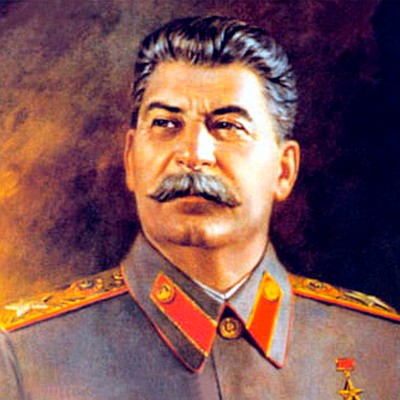 |
|
|
|